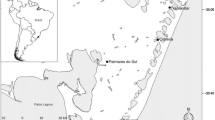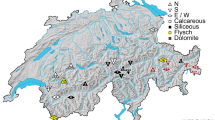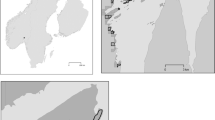Abstract
Vegetation of arid and semiarid environments has in general a patchy distribution. Our objective was to (a) determine several qualitative and quantitative analytical characteristics of vegetation patches in an arid zone of Patagonia, Argentina, and (b) investigate relationships between them. Annual precipitation in this area was 200 mm during 1999–2005. Eight transects involving ten patches each were studied within a 15 × 15 km area. Mean (±1 SE) values (n = 80) in the vegetation patches were 315 ± 25 and 207 ± 16 cm for the greatest and lowest patch diameter, respectively; 23 ± 2 cm for mound height; 113 ± 12 cm for maximum vegetation height; and 170 ± 18 cm and 58 ± 2% for distance to the next vegetation patch and vegetation patch cover within a transect, respectively. Correlations between greatest and lowest diameters, mound height, maximum plant height and distance to the closest vegetation patch were all significant (P < 0.01; n = 80). In all vegetation patches, the greatest and lowest frequencies were found for the grass Stipa spp. (71.2%) and the shrub Grindelia chiloensis (Cornel.) Cabrera (12.5%). Stipa spp. and the shrub Atriplex lampa (Moq.) D. Dietr. showed the highest simultaneous frequency (50%). A reasonable association among species (>45%) was found for Stipa spp., Atriplex lampa and the shrubs Larrea divaricata Cav., Lycium chilense Miers ex Bertero and Junellia ligustrina (Lag.) Moldenke. Larrea divaricata and Atriplex lampa contributed more than 84% of the total patch standing crop (5,777 ± 435 g). Average patch size and specific diversity were 5.93 ± 0.33 m2 and 1.31 ± 0.11, respectively. Aboveground standing crop of the two dominant shrubs decreased as plant species diversity increased (P < 0.05). Conservation of vegetation patches is crucial to prevent increased soil erosion and desertification in the study ecological system.






Similar content being viewed by others
References
Aarssen LW, Turkington R (1985) Vegetation dynamics and neighbor associations in pasture-community evolution. J Ecol 73:585–603. doi:10.2307/2260496
Aguiar MR, Sala OE (1997) Seed distribution constrains the dynamics of the Patagonian steppe. Ecology 78:93–100
Ares JO, Beeskow AM, Bertiller MB, Rostagno CM, Irisarri MP, Anchorena J, Defossé GE, Merino CA (1990) Structural and dynamic characteristics of overgrazed grasslands of northern Patagonia. In: Breymeyer A (ed) Managed grasslands: regional studies. Elsevier, Amsterdam, pp 149–175
Barbour MG (1969) Age and space distribution of the desert shrub Larrea divaricata. Ecology 50(4):679–685. doi:10.2307/1936259
Basanta M, Díaz Vizcaíno E, Casal M, Morey M (1989) Diversity measurements in shrubland communities of Galicia (NW Spain). Vegetatio 82:105–112. doi:10.1007/BF00045024
Bates JD, Miller RF, Svejcar TJ (2000) Understory dynamics in cut and uncut western juniper woodlands. J Range Manag 53:119–126. doi:10.2307/4003402
Bertiller MB, Bisigato AJ, Carrera AC, del Valle HF (2004) Estructura de la vegetación y funcionamiento de los ecosistemas del Monte chubutense. Bol Soc Arg Bot 39:139–158
Bisigato AJ, Bertiller MB (1997) Grazing effects on patchy dryland vegetation in northern Patagonia. J Arid Environ 36:639–653. doi:10.1006/jare.1996.0247
Black CA, Evans DD, Ensminger LE, White JL, Clark FE (1965) Methods of soil analysis. Part 1. Physical and mineralogical properties including statistics of measurement and sampling. American Society of Agronomy No. 9. Inc. Publisher, Madison
Bonvissuto GL (2006) Establecimiento de plántulas de gramíneas y arbustos dentro y entre isletas de vegetación en el Monte Austral Neuquino. Doctoral thesis, Universidad Nacional del Sur, Bahía Blanca
Bonvissuto GL, Busso CA (2006) Ascenso hidráulico en y entre isletas de vegetación en la zona árida de Argentina. Phyton Int. J Exp Bot 75:55–70
Bonvissuto GL, Busso CA (2007a) Seed rain in and between vegetation patches in arid Patagonia, Argentina. Phyton Int. J Exp Bot 76:47–59
Bonvissuto GL, Busso CA (2007b) Germination of grasses and shrubs under various water stress and temperature conditions. Phyton Int. J Exp Bot 76:119–131
Bozzo JA, Beasom SL, Fulbright TF (1992) Vegetation responses to two brush management practices in south Texas. J Range Manag 45:170–175. doi:10.2307/4002778
Brisson J, Reynolds JF (1994) The effect of neighbors on root distribution in a creosotebush (Larrea tridentata) population. Ecology 75:1693–1702. doi:10.2307/1939629
Burkhardt JW, Tisdale EW (1969) Nature and successional status of western juniper vegetation in Idaho. J Range Manag 22:264–270. doi:10.2307/3895930
Busso CA (1997) Towards an increased and sustainable production in semiarid rangelands of Central Argentina: two decades of research. J Arid Environ 36:197–210. doi:10.1006/jare.1996.0205
Bustos JC (1995) El efecto del clima en los ovinos. II. Uso de cortinas de arbustos para atenuar la mortandad perinatal de corderos. Presencia 35:5–8
Cabrera AL (1971) Fitogeografía de la República Argentina. Bol Soc Arg Bot 14(1–2):1–42
Canfield R (1941) Application of the line interception method in sampling range vegetation. J For 39:388–394
Carter MR (1993) Soil sampling and methods of analysis. Canadian Society of Soil Science, Lewis Publishers, Boca Raton
Cecchi GA (2000) Relación entre la textura y salinidad de la superficie del suelo y la cobertura herbácea en islas de vegetación del monte rionegrino. In: Proceedings of the XVIIº Congreso Argentino de Ciencias.del Suelo. Mar del Plata, Argentina
Chambers JC, McMahon JA (1994) A day in the life of a seed: movements and fates of seeds and their implications for natural and managed systems. Annu Rev Ecol Syst 25:263–292. doi:10.1146/annurev.es.25.110194.001403
Connell JH (1978) Diversity in tropical rain forests and coral reefs. Science 199:1302–1310. doi:10.1126/science.199.4335.1302
Defossé GE, Bertiller MB, Robberecht R (1997) Effects of topography, soil moisture, wind, and grazing on Festuca seedlings in a Patagonian grassland. J Veg Sci 8:677–684. doi:10.2307/3237372
Erickson HE, Soto P, Jonson DW, Roath B, Hunsaker C (2005) Effects of vegetation patches on soil nutrient pools and fluxes within a mixed-conifer forest. For Sci 51:211–220
Ferrer JA, Irisarri JA (1989) Suelos. Plano Nº 25. In Estudio Regional de Suelos. Relevamiento y Prioritación de Áreas con Posibilidades de Riego. Expte. Nº 181. Consejo Federal de Inversión. Dirección de Cooperación Técnica. Área de Infraestructura Hídrica. Secretaría de Estado del Copade Pcia. Neuquén
Frangi JL (1978) Ecología de la Vegetación. Manual de Trabajos Prácticos. Universidad Nacional de La Plata
Fryrear DW, Stubbendieck J, McCully WG (1973) Grass seedling response to wind and windblown sand. Crop Sci 13:622–625
Fulbright TE (1991) Why does brush increase? In: Welch TG (ed) Proceedings of brush management symposium; May 1991, Texas A&M University, College Station, Giddings, pp 6–15
Fulbright TE (1996) Viewpoint: a theoretical basis for planning woody plant control to maintain species diversity. J Range Manag 49:554–559. doi:10.2307/4002299
Gile LH, Gibbens RP, Lenz JM (1998) Soil-induced variability in root systems of creosotebush (Larrea tridentata) and tarbush (Flourensia cernua). J Arid Environ 39:57–78. doi:10.1006/jare.1998.0377
Gosz JR, Milne B (2005) Creosotebush biomass and productivity at five points. In: Dimensions of certain perennial plants on the Sevilleta National Wildlife Refuge. Sevilleta LTER Research. http://sevilleta.unm.edu/research/local/plant/dimensions/documents/creosote_biomass_and_productivity_at_five_points_ver2.doc
Grime JP (1981) Plant strategies and vegetation processes. John Wiley and Sons, New York
Haase P, Pugnaire FI, Clark SC, Incoll LD (1996) Spatial patterns in a two-tiered semi-arid shrubland in Southeastern Spain. J Veg Sci 7:527–534. doi:10.2307/3236301
HilleRisLambers R, Rietkerk M, Van Den Bosch F, Herbert HT, Hans de Kroon P (2001) Vegetation pattern formation in semi-arid grazing systems. Ecology 82:50–61
INTA EEA Pergamino (1998) V Curso de Física de Suelos. Técnicas de Laboratorio. Sección Suelos
INTA-GTZ (1996) Sistema Regional de Soporte de Decisiones. Pcia. Neuquén. Un diagnóstico del estado problemas y estrategias de desarrollo del sector agropecuario de la Patagonia Norte. INTA EEA Bariloche. Proyecto Prodeser. Convenio INTA-GTZ
Italconsult Argentina (1966) Proyecto de Riego y Colonización de La Picaza. Tomo I: Relación General y Tomo III: Apéndices. Pcia. Neuquén
Jackson JBC, Buss LW, Cook RE (1985) Population biology and evolution of clonal organisms. Yale University Press, New Haven
Ladyman J (2003) Gutierrezia sarothrae (Pursh) Britton and Rusby. http://fs.fed.us/global/iitfpdf/shrubs/Gutierrezia%20sarothrae.pdf
Lascano R, Landivar J (1997) Soil gravimetric water content: measurement and calculations. Texas Agricultural Experiment Station. Lubbock and Corpus Christi. http://plantstress.com/Articles/drought_i/drought_i_files/SOIL%20GRAVIMETRIC.htm
Lee CA, Lauenroth WK (1994) Spatial distribution of grass and shrubs root systems in the shortgrass steppe. Am Midl Nat 137:117–123. doi:10.2307/2426206
Longland WS, Bateman SL (2002) Viewpoint: the ecological value of shrub islands on disturbed sagebrush rangelands. J Range Manag 55:571–575. doi:10.2307/4004000
Ludwig JA, Tongway DJ (1995) Spatial organization of landscapes and its function in semi-arid woodlands, Australia. Landsc Ecol 10:51–63. doi:10.1007/BF00158553
Ludwig JA, Eager RW, Williams RJ, Lowe LM (1999) Declines in vegetation patches, plant diversity, and grasshopper diversity near cattle watering-points in the Victoria River District, Northern Australia. Range J 21:135–149. doi:10.1071/RJ9990135
Ludwig JA, Wilcox BP, Breshears DD, Tongway DJ, Imeson AC (2004) Vegetation patches and runoff-erosion as interacting ecohydrological processes in semiarid landscapes. Ecology 86:288–297. doi:10.1890/03-0569
Lyford F, Qashu H (1969) Infiltration rates as affected by desert vegetation. Water Resour Res 5:1373–1376. doi:10.1029/WR005i006p01373
Mack RN, Pyke DA (1984) The demography of Bromus tectorum: the role of microclimate, grazing and disease. J Ecol 72:731–748. doi:10.2307/2259528
Marshall KA (1995) Larrea tridentata. In: Fisher WC (ed) The fire effects information system (Online). US Department of Agriculture, Forest Service; Intermountain Research Station, Intermountain Fire Sciences Laboratory, Missoula. http://fs.fed.us/database/feis
Montaña C (1992) Decolonization of bare areas in two-phase mosaics of an arid ecosystem. J Ecol 80:315–327. doi:10.2307/2261014
Morello J (1956) Estudios botánicos en las regiones áridas de la Argentina. III: Reacciones de las plantas a los movimientos del suelo en Neuquén extra-andino. Rev Agron Nor Arg 2:79–152
Morello J (1958) La provincia fitogeográfica del Monte. Opera Lilloana II. Instituto “Miguel Lillo”, Universidad Nacional de Tucumán
Movia CP, Ower GH, Pérez CE (1982) Estudio de la Vegetación Natural. Ministerio de Hacienda, Subsecretaría de Recursos Naturales Pcia. Neuquén
Nelson D (1999) Restoration of vegetation and soil patterning in semi-arid mulga lands of Eastern Australia. http://horticulture.coafes.umn.edu/vd/h5015/99papers/nelson.htm
Northrup BK, Stuth JW, Archer S, McKown D, Crane A (1995) Structure of shrub clusters in a subtropical savanna in South Texas. In: NE West Salt Lake City Utah (ed) Rangelands in a sustainable biosphere. Proceedings of the Fifth International Range Congress
Norton BE, Bermant DJ (1977) Plant replacement and population interactions of perennials in salt desert shrub vegetation. Annual Meeting of the Ecological Society of America, Lansing
Olsen SR, Sommers LE (1982) Phosphorus. In: Miller RH, Keeney DR (eds) Methods of soil analysis. Agronomy # 9, ASA SSSA, Madison, pp 403–430
Osman A, Pieper RD (1988) Growth of Gutierrezia sarothrae seedlings in the field. J Range Manag 41:92–93. doi:10.2307/3898801
Pielou EC (1977) Mathematical ecology. Wiley, New York
Pyke DA, Archer S (1991) Plant-plant interactions affecting plant establishment and persistence on revegetated rangeland. J Range Manag 44:550–557. doi:10.2307/4003035
Raven PH, Evert RF, Eichhorn SE (1986) Biology of plants. Worth Publishers Inc, New York
Rostagno CM, del Valle HF (1988) Mounds associated with shrubs in aridic soils of northeastern Patagonia: characteristics and probable genesis. Catena 15:347–359. doi:10.1016/0341-8162(88)90056-2
Russell PF, Rao TR (1940) On habitat and association of species of anopheline larvae in south-eastern Madras. J Malar Inst India 3:153–178
Sala OE, Lahuenroth WK (1982) Small rainfall events: an ecological role in semiarid regions. Oecologia 53:301–304. doi:10.1007/BF00389004
Sánchez G, Puigdefabregas J (1994) Interactions of plant growth and sediment movement on slopes in a semiarid environment. Geomorphology 9:243–260. doi:10.1016/0169-555X(94)90066-3
Schenk HJ (1999) Clonal splitting in desert shrubs. Plant Ecol 141:41–52. doi:10.1023/A:1009895603783
Schenk HJ (2004) Sizes and shapes of root systems in pulse-driven ecosystems. http://ag.arizona.edu/research/Schwinn/abstracts.rtf
Schenk HJ, Holzapfel C, Hamilton JG, Mahall BE (2003) Spatial ecology of a small desert shrub on adjacent geological substrates. J Ecol 91:383–395. doi:10.1046/j.1365-2745.2003.00782.x
Schulte LA, Niemi GJ (1998) Bird communities of early-successional burned and logged forest. J Wildl Manag 64:1418–1429. doi:10.2307/3802008
Servicio Meteorológico Nacional (1958) Estadísticas climatológicas 1941-1950. Publicación B1. No 3. Ministerio de Aeronáutica, Argentina
Shannon CE (1948) A mathematical theory of communication. Bell Syst Tech J 27:379–423
Silvertown J, Wilson JB (1994) Community structure in a desert perennial community. Ecology 75:409–417. doi:10.2307/1939544
Soil Survey Staff (1975) Soil taxonomy. USDA agriculture handbook no. 436. US Government Printing Office, Washington DC
Soriano A (1956) Los distritos florísticos de la Provincia Patagónica. Rev Inv Agric 10:323–348
Soriano A, Sala OE, Perelman SB (1994) Patch structure and dynamics in a Patagonian arid steppe. Vegetatio 111:127–135. doi:10.1007/BF00040332
SSSA (1996) Methods of soil analysis. Part 3. Chemical methods—SSSA book series no. 5. Soil Sci Soc Amer and Am Soc Agron, Madison
Sutter GC, Brigham RM (1998) Avifaunal and habitat changes resulting from conversion of native prairies to crested wheatgrass: patterns at songbird community and species level. Can J Zool 76:869–875. doi:10.1139/cjz-76-5-869
Thorsteinsson I, Olafsson G, van Dyne GM (1971) Range resources of Iceland. J Range Manag 24:86–93. doi:10.2307/3896512
Tirmenstein D (1999) USDA forest service rocky mountain research station, fire sciences laboratory (October 2001). Fire Effects Information System. http://fs.fed.us/database
Tongway DJ, Ludwig JA (1989) Mulga log mounds: fertile patches in the semi-arid woodlands of eastern Australia. Aust J Ecol 14:263–268. doi:10.1111/j.1442-9993.1989.tb01436.x
Tongway DJ, Ludwig JA (1990) Vegetation patterning in semi-arid mulga lands of eastern Australia. Aust J Ecol 15:23–34. doi:10.1111/j.1442-9993.1990.tb01017.x
Tongway DJ, Ludwig JA (1996) Rehabilitation of semi-arid landscapes in Australia. I. Restoring productive soil patches. Restor Ecol 4:388–397. doi:10.1111/j.1526-100X.1996.tb00191.x
USDA (1954) Diagnóstico y Rehabilitación de Suelos Salinos y Sódicos. Manual de Agricultura No. 60
Walkley A, Black IA (1934) An examination of Degtjareff method for determining soil organic matter and a proposed modification of the chromic acid titration method. Soil Sci 37:29–37. doi:10.1097/00010694-193401000-00003
West NE (1989) Spatial pattern—functional interactions in shrub-dominated plant communities. In: The biology and utilization of shrubs. Academic Press Inc. pp 283–305
Wilcox BP, Breshears DD (1994) Hydrology and ecology of piñon-juniper woodlands: conceptual framework and field studies. In: Desired future conditions for piñon-juniper ecosystems. Rocky Mountain Forest and Range Experiment Station, Technical Report INT-258, Fort Collins, CO, pp 109–119. www.fs.fed.us/database/feis/plants..nical_and_ecological_characteristics.html
Wilson JB, Briske DD (1978) Drought and temperature effects on the establishment of blue grama seedlings. In: Proceedings of the First International Rangeland Congress. Denver, pp 359–361
Yeaton RI (1978) A cyclical relationship between Larrea tridentata and Opuntia leptocaulis in the northern Chihuahuan Desert. J Ecol 66:651–656. doi:10.2307/2259156
Author information
Authors and Affiliations
Corresponding author
Rights and permissions
About this article
Cite this article
Busso, C.A., Bonvissuto, G.L. Structure of vegetation patches in northwestern Patagonia, Argentina. Biodivers Conserv 18, 3017–3041 (2009). https://doi.org/10.1007/s10531-009-9622-6
Received:
Accepted:
Published:
Issue Date:
DOI: https://doi.org/10.1007/s10531-009-9622-6




